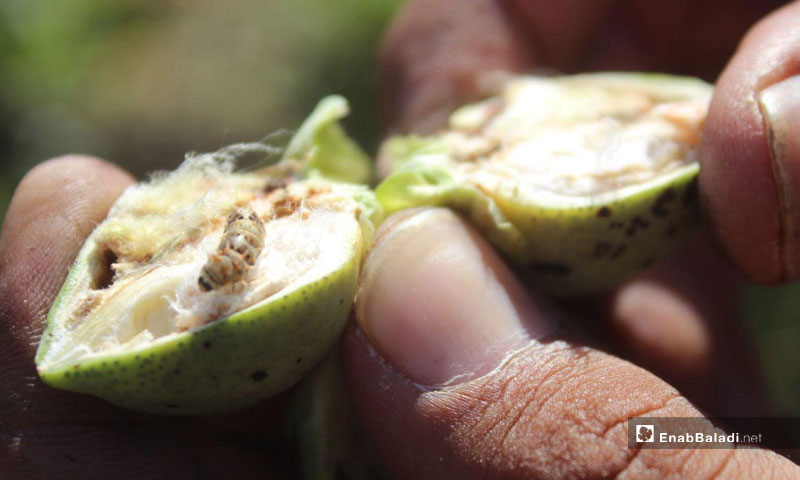This year’s cotton season in al-Ghab Plain, rural Hama, was unsuccessful despite all the farmers attempts at providing the seeds and fertilizers, for they have been met with a disaster, represented by the pests that attacked the plants, prominently the “earias insulana.”
The agricultural activity returned to the al-Ghab Plain after years of absence. The past months have witnessed the cultivation of dozens of hectares in the northern part of the Plain, when the farmers managed to get the needed agricultural supplies and secured outlets for the production in other governorates.
The cost of planting one dunum of cotton is 4,000 Syrian pounds for plowing the land, 15,000 pounds for irrigation, 9,000 pounds for fertilizers and 10,000 for workers, this is in addition to the costs of transport and harvesting during the harvest season, said Mohammed al-Abdullah, one of al-Ghab Plain’s farmers.
“A Season Ruined by a Worm”
The agricultural engineer Anas Abu Tarboush told Enab Baladi that al-Ghab Plain’s cotton season has, this year, been attacked by the earias insulana, which is a small butterfly about nine millimeters long, with green front wings.
Fresh larvae feed on plant tissues, according to the agricultural engineer, who added that they later attack the leafy buds, which sprout in a crumpled form. When the larvae grow larger, they attack the flower buds and eat them, causing them to fall to the ground.
The life cycle of the worm does not stop at that point, but it pierces the cotton nuts from the inside and feeds on its contents. The worm’s feces are thrown out of the nut through the entry hole, in small cohesive masses, which damages the infected nuts.
Abu Tarboush explained that the life cycle of the insect lasts for five to six generations a year. It can be controlled via using “anti-deflating” pesticides, such as Lufenuron, at the onset of the infection and in the first age stage of the larvae.
The nutrition blockers, “emamectin benzoate,” can be used, in addition to “pyrethroid insecticides” at the beginning of the pest attack and before the larvae’s entry to the cotton nuts.
In the event of fundamental damage, specialized insecticides such as flubendiamide should be used.
According to the agricultural engineer, about 700 dunums of the al-Ghab Plain’s lands are planted with cotton, distributed over different areas.
Soaring Costs
Cotton cultivation is known to be expensive in comparison to other crops. This is associated with imported seed, fertilizer, pesticides and fuel high costs, as well as the expensive wages of workers who prepare the agricultural land and the labor force.
The engineer said that the mentioned issues increased the costs, and the pest attack inflated the economic situation, estimating the cost of planting a single dunum with 100 thousand Syrian pounds.
In relation to this, Shujaa al-Saleh, the head of the local council in the Zaqqum town, spoke of other difficulties facing the area’s agriculture, including water shortage.
He pointed out that lacking water has forced the farmers to buy it from owners of artesian aquifers, the cost of a single hour of which is more than three thousand Syrian pounds.
Despite all these difficulties, the farmer Adnan al-Halbi hopes to have a good cotton production, as he has cultivated 20 dunums after he managed to purchase seeds and fertilizers from merchants.
The pests attacking cotton are not limited to the “earias insulana,” for the farmer has pointed to another called the “greenhouse whitefly,” which increases the farmers losses and negatively affects their living conditions.
Syria ranked second in the world in cotton production in terms of unit area, before the revolution began, and ranked third, at the level of Asia, in the production of organic cotton, but the war played a major role in the decline of production because of the reluctance of farmers to plant as a result of high costs.
Syria’s pre-war cotton production was more than 1 million tons a year, witnessing a 93% decline in the past six years, where production was only 50 to 100 tons in 2015.
Syrians call cotton “white gold” driven by its importance within the Syrian economy; cotton competes with oil in terms of revenues, especially that it used to generate job opportunities for hundreds of thousands of people.

